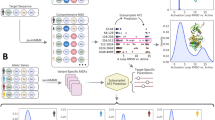Abstract
Statistical mechanics is one of the most successful areas of physics. Yet, almost 150 years since its inception, its foundations and basic postulates are still the subject of debate. Here we suggest that the main postulate of statistical mechanics, the equal a priori probability postulate, should be abandoned as misleading and unnecessary. We argue that it should be replaced by a general canonical principle, whose physical content is fundamentally different from the postulate it replaces: it refers to individual states, rather than to ensemble or time averages. Furthermore, whereas the original postulate is an unprovable assumption, the principle we propose is mathematically proven. The key element in this proof is the quantum entanglement between the system and its environment. Our approach separates the issue of finding the canonical state from finding out how close a system is to it, allowing us to go even beyond the usual boltzmannian situation.
This is a preview of subscription content, access via your institution
Access options
Subscribe to this journal
Receive 12 print issues and online access
$209.00 per year
only $17.42 per issue
Buy this article
- Purchase on Springer Link
- Instant access to full article PDF
Prices may be subject to local taxes which are calculated during checkout
 corresponding to the restriction R.
corresponding to the restriction R.


Similar content being viewed by others
References
Mandl, F. Statistical Physics 2nd edn, Ch. 2, 40–41 (Wiley, New York, 1988).
Khinchin, A. I. Mathematical Foundations of Statistical Mechanics Ch. 3, 44–47 (Dover, New York, 1949).
Bocchieri, P. & Loinger, A. Ergodic foundation of quantum statistical mechanics. Phys. Rev. 114, 948–951 (1959).
Lloyd, S. Black Holes, Demons, and the Loss of Coherence. Ch. 3, 79–93, Thesis, Rockefeller Univ. (1988).
Gemmer, J., Michel, M. & Mahler, G. Quantum Thermodynamics Vol. 657 (Lecture Notes in Physics, Springer, Berlin, 2004).
Goldstein, S., Lebowitz, J. L., Tumulka, R. & Zanghì, N. Canonical typicality. Phys. Rev. Lett. 96, 050403 (2006).
Landau, L. D. & Lifshitz, E. M. Statistical Physics Ch. 3, 78–80 (Pergamon, London, 1958).
Nielsen, M. A. & Chuang, I. L. Quantum Computation and Quantum Information Ch. 9, 403–409 (Cambridge Univ. Press, Cambridge, 2000).
Lubkin, E. Entropy of an n-system from its correlation with a k-reservoir. J. Math. Phys. 19, 1028–1031 (1978).
Lloyd, S. & Pagels, H. Complexity as thermodynamic depth. Ann. Phys. 188, 186–213 (1988).
Page, D. N. Average entropy of a subsystem. Phys. Rev. Lett. 71, 1291–1294 (1993).
Sen, S. Average entropy of a quantum subsystem. Phys. Rev. Lett. 77, 1–3 (1996).
Sommers, H.-J. & Zyczkowski, K. Statistical properties of random density matrices. J. Phys. A: Math. Gen. 37, 8457–8466 (2004).
Milman, V. D. & Schechtman, G. Asymptotic Theory of Finite-Dimensional Normed Spaces Ch. 2, 5–6 (Lecture Notes in Mathematics, Vol. 1,200, Springer, Berlin, 1986) and 140–141 Appendix V.
Hayden, P., Leung, D. W. & Winter, A. Aspects of generic entanglement. Commun. Math. Phys. 265, 95–117 (2006).
Lloyd, S. Capacity of the noisy quantum channel. Phys. Rev. A 55, 1613–1622 (1997).
Horodecki, M., Oppenheim, J. & Winter, A. Partial quantum information. Nature 436, 673–676 (2005).
Popescu, S., Short, A. J. & Winter, A. Entanglement and the foundations of statistical mechanics: Individual states vs averages. Preprint at <http://arxiv.org/abs/quant-ph/0511225> (2005).
Tasaki, H. From quantum dynamics to the canonical distribution: General picture and a rigorous example. Phys. Rev. Lett. 80, 1373–1376 (1998).
Michel, M., Mahler, G. & Gemmer, J. Fourier’s law from Schrödinger dynamics. Phys. Rev. Lett. 95, 180602 (2005).
Breuer, H. P., Gemmer, J. & Michel, M. Non-Markovian quantum dynamics: Correlated projection superoperators and Hilbert space averaging. Phys. Rev. E 73, 016139 (2006).
Gemmer, J. & Michel, M. Thermalization of quantum systems by finite baths. Europhys. Lett. 73, 1–7 (2006).
Acknowledgements
The authors would like to thank Y. Aharonov and N. Linden for discussions. S.P., A.J.S. and A.W. acknowledge support through the UK EPSRC project ‘QIP IRC’. In addition, S.P. also acknowledges support through EPSRC ‘Engineering-Physics’ grant GR/527405/01 and A.W. acknowledges a University of Bristol Research Fellowship.
Author information
Authors and Affiliations
Corresponding author
Ethics declarations
Competing interests
The authors declare no competing financial interests.
Rights and permissions
About this article
Cite this article
Popescu, S., Short, A. & Winter, A. Entanglement and the foundations of statistical mechanics. Nature Phys 2, 754–758 (2006). https://doi.org/10.1038/nphys444
Received:
Accepted:
Published:
Issue Date:
DOI: https://doi.org/10.1038/nphys444
This article is cited by
-
Stalled response near thermal equilibrium in periodically driven systems
Nature Communications (2024)
-
Reviving product states in the disordered Heisenberg chain
Nature Communications (2023)
-
Quantum simulation of thermodynamics in an integrated quantum photonic processor
Nature Communications (2023)
-
No second law of entanglement manipulation after all
Nature Physics (2023)
-
Preparing random states and benchmarking with many-body quantum chaos
Nature (2023)



